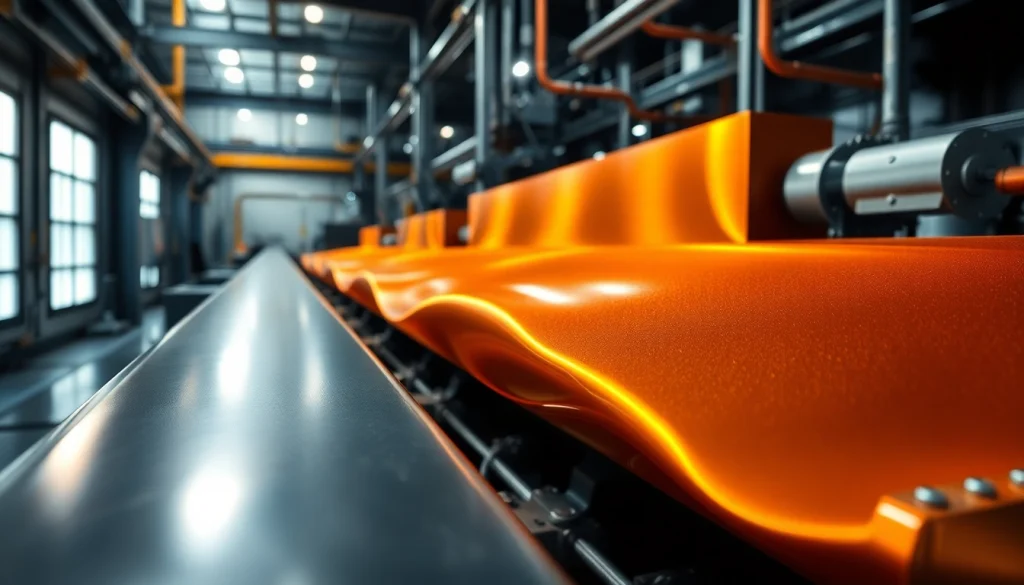What is EP Coating?
Definition and Process Overview
Electrophoretic coating (EP coating), commonly referred to as e-coating, is an advanced surface finishing technology used to coat conductive materials, predominantly metals. This process utilizes an electric current to deposit a paint-like coating onto the surface of the substrate. The e-coating process generally consists of several stages: pretreatment, electrophoretic deposition, and curing. In the pretreatment phase, substrates are thoroughly cleaned and treated to enhance their adhesion properties. The electrophoretic deposition then takes place in a bath containing paint particles dispersed in water or a solvent. An electric field is applied, which draws the charged paint particles towards the oppositely charged substrate. Finally, curing is performed using heat, which results in a durable, uniform coating suitable for various applications.
This ep coating method offers several advantages, making it a preferred choice in industries such as automotive, electronics, and manufacturing.
Historical Development of Electrophoretic Coating
The origins of electrophoretic coating can be traced back to the early 20th century, with advancements in electrical technology enabling the development of coating methods that utilized electrical fields to effectively apply coatings. The evolution of this technique saw its first significant industrial application in the automotive sector during the 1970s, where manufacturers started utilizing it for corrosion protection of car bodies. The initial focus was on improving resistance to environmental factors and enhancing aesthetic appeal through uniform coatings.
Over the years, the technology has evolved significantly, with innovations improving coating materials, application techniques, and curing processes. Today, the e-coating process is a highly automated procedure that has become an integral part of the manufacturing process in numerous industries.
Key Characteristics of EP Coating
EP coatings have several defining characteristics that contribute to their wide adoption:
- Uniform Coat: The electrophoretic process ensures that the coating is evenly distributed, even in complex geometries.
- Thickness Control: The thickness of the coating can be precisely controlled, typically ranging from 15 to 30 microns.
- Corrosion Resistance: E-coating provides excellent resistance against corrosion and wear, extending the lifespan of coated components.
- Environmental Compatibility: Many e-coating systems are environmentally friendly, using water-based systems that reduce VOC emissions.
- Adhesion Properties: The process produces strong, durable bonds that enhance the adhesion of additional coatings or finishes.
Benefits of EP Coating
Enhanced Corrosion Resistance
One of the main advantages of EP coating is its superior corrosion resistance. The electrocoating process produces a uniform layer that interacts effectively with the substrate material, creating a barrier that protects against moisture, chemicals, and other environmental factors that promote corrosion. This property is particularly beneficial in industries where components are exposed to harsh conditions, such as automotive and marine applications.
Uniform Coating Application
The ability to achieve a consistent coating thickness over intricate shapes and complex geometries is a critical benefit of EP coating. Unlike traditional spraying or brushing methods, e-coating deposits paint evenly, ensuring that even hidden or complex areas receive the same protective treatment. This uniformity reduces the risk of weak points that could lead to corrosion or failure during operation.
Environmental Benefits of Electrophoretic Coating
As environmental regulations become stricter, the need for eco-friendly processes intensifies. EP coating aligns with these objectives as it typically uses water-based paints that emit low levels of volatile organic compounds (VOCs). Furthermore, the process is often more efficient, as the coating material is deposited directly onto the substrate, minimizing waste and making it more sustainable compared to conventional painting methods.
Applications of EP Coating
Uses in Automotive Industry
The automotive industry is one of the primary users of electrophoretic coating technology. E-coating is essential in the production of automobile bodies, chassis, and various components where protective measures against rust and corrosion are paramount. The even coating provided by e-coating ensures that all areas of the vehicle are equally protected, enhancing the overall durability and longevity of vehicles.
EP Coating in Electronics
Another significant application of EP coating is in the electronics industry. The process is employed to provide protective finishes for various electronic components. For example, connectors, enclosures, and other components made from metals are often coated with electrophoretic paints to offer protection against electrostatic discharge (ESD), moisture, and mechanical wear. This ensures that electronic devices remain reliable even in challenging environments.
Other Industrial Applications
Beyond automotive and electronics, electrophoretic coating finds utility in a variety of industrial settings. This includes applications in appliances, construction materials, and manufacturing components. In each of these cases, the advantages of uniform coating, corrosion resistance, and environmental compliance make it a favorable choice. Industries such as furniture manufacturing also benefit from EP coatings for aesthetic finishes that are durable and easy to maintain.
EP Coating vs Other Coating Methods
Comparison with Powder Coating
While powder coating is a popular alternative for achieving durable surface finishes, it has its own set of limitations compared to EP coating. One of the primary differences is that powder coating requires a high-temperature curing process, whereas EP coatings are often cured at lower temperatures. This allows EP coatings to be applied on temperature-sensitive substrates.
Moreover, e-coating can achieve superior coverage in complex parts due to its ability to provide uniform thickness, while powder coating may leave some areas inadequately coated unless properly applied. However, powder coatings tend to be more robust and can provide a thicker coating, which might be beneficial in certain applications.
Advantages Over Traditional Painting
Compared to traditional painting methods, EP coating provides numerous advantages. E-coating minimizes the risk of runs and drips commonly associated with liquid paint application, ensuring a better finish. Additionally, the precision of the coating application allows for less overspray, reducing material costs. The curing process in e-coating results in a tougher finish due to the crosslinking of polymer chains, leading to increased durability. Finally, the process is highly automated, resulting in increased efficiency and reduced labor costs in production lines.
Electrophoretic Deposition vs Anodizing
Electrophoretic deposition (EPD) should not be confused with anodizing, which is another popular surface treatment. Anodizing involves the conversion of the metal surface into a decorative, protective oxide finish through an electrolytic process. While anodizing mainly serves to prevent corrosion and enhance appearance, it cannot provide the same level of customization and color options available with EP coatings. Furthermore, EPD is generally used on conductive materials, making it versatile for a broader range of industrial applications while anodizing is predominantly applicable to aluminum and titanium alloys.
Future Trends in EP Coating Technology
Innovations in Coating Processes
Innovation in EP coating technology is ongoing, with significant strides in developing smarter coating systems that leverage data analytics and IoT technologies. These innovations aim to enhance process control by monitoring application conditions and adjusting parameters in real-time for optimal performance. Furthermore, advancements in coating chemistry are leading to the development of multifunctional coatings that not only provide corrosion resistance but also integrate features such as anti-bacterial properties and self-cleaning capabilities.
Market Growth and Demand for EP Coatings
The demand for EP coatings is on the rise, driven by increasing environmental regulations and the need for durable, high-performance coatings. Market research indicates a growing trend in the automotive and electronics industries, particularly as manufacturers strive to enhance product longevity and reduce maintenance costs. This demand is expected to fueled further by advancements in material science, leading to new formulations that enhance coating performance.
Sustainability and Eco-friendly Advances
With sustainability becoming a critical focus for industries worldwide, EP coating technology is making strides to align with eco-friendly practices. Many coating formulations are now designed to be low in VOCs, and the shift towards water-based systems is paving the way for greener production methods. Additionally, the recyclability of e-coated components is creating synergies in the circular economy, promoting a sustainable lifecycle for manufactured goods.


